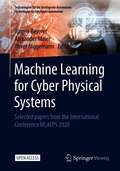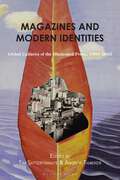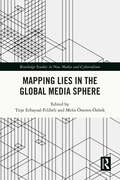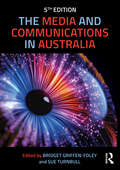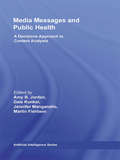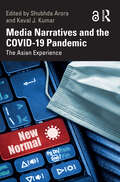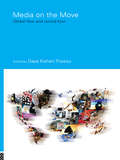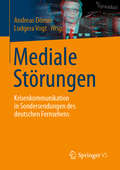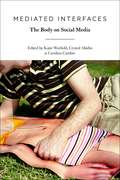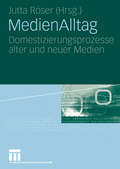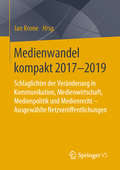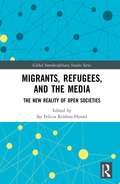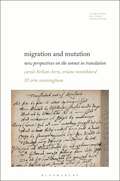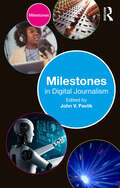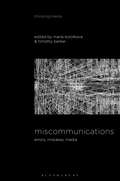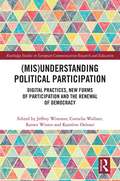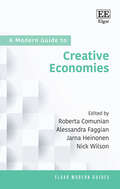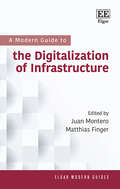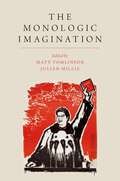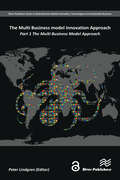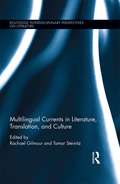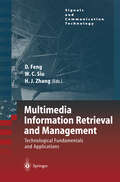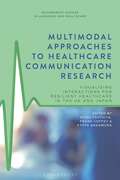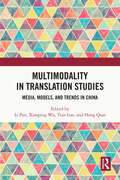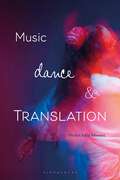- Table View
- List View
Machine Learning for Cyber Physical Systems: Selected papers from the International Conference ML4CPS 2020 (Technologien für die intelligente Automation #13)
This open access proceedings presents new approaches to Machine Learning for Cyber Physical Systems, experiences and visions. It contains selected papers from the fifth international Conference ML4CPS – Machine Learning for Cyber Physical Systems, which was held in Berlin, March 12-13, 2020. Cyber Physical Systems are characterized by their ability to adapt and to learn: They analyze their environment and, based on observations, they learn patterns, correlations and predictive models. Typical applications are condition monitoring, predictive maintenance, image processing and diagnosis. Machine Learning is the key technology for these developments.
Magazines and Modern Identities: Global Cultures of the Illustrated Press, 1880–1945
In the late nineteenth and early twentieth century, ideals of technological progress and mass consumerism shaped the print cultures of countries across the globe. Magazines in Europe, the USA, Latin America, and Asia inflected a shared internationalism and technological optimism. But there were equally powerful countervailing influences, of patriotic or insurgent nationalism, and of traditionalism, that promoted cultural differentiation. In their editorials, images, and advertisements magazines embodied the tensions between these domestic imperatives and the forces of global modernity.Magazines and Modern Identities explores how these tensions played out in the magazine cultures of ten different countries, describing how publications drew on, resisted, and informed the ideals and visual forms of global modernism. Chapters take in the magazines of Australia, Europe and North America, as well as China, The Soviet Turkic states, and Mexico. With contributions from leading international scholars, the book considers the pioneering developments in European and North American periodicals in the modernist period, whilst expanding the field of enquiry to take in the vibrant magazine cultures of east Asia and Latin America. The construction of these magazines' modern ideals was a complex, dialectical process: in dialogue with international modernism, but equally responsive to their local cultures, and the beliefs and expectations of their readers. Magazines and Modern Identities captures the diversity of these ideals, in periodicals that both embraced and criticised the globalised culture of the technological era.
Mapping Lies in the Global Media Sphere (Routledge Studies in New Media and Cyberculture)
This volume addresses the concept of “(in)nocent lies” in the media – beyond the concept of misleading information online, this extends to a deliberate effort to spread misinformation, disinformation and conspiracy theories – and proposes a critical approach to tackle the issue in related interdisciplinary fields. The book takes a multidisciplinary and international approach, addressing the digital divide and global inequality, as well as algorithmic bias, how misinformation harms vulnerable groups, social lynching and the effect of misinformation on certain social, political and cultural agendas, among other topics. Arranged thematically, the chapters paint a nuanced and original picture of this issue. This book will be of interest to students and academics in the areas of digital media, media and politics, journalism, development studies, gender and race.
The Media and Communications in Australia
At a time when the traditional media have been reshaped by digital technologies and audiences have fragmented, people are using mediated forms of communication to manage all aspects of their daily lives as well as for news and entertainment. The Media and Communications in Australia offers a systematic introduction to this dynamic field. Fully updated and expanded, this fifth edition outlines the key media industries – from print, sound and television to film, gaming and public relations – and explains how communications technologies have changed the ways in which they now operate. It offers an overview of the key approaches to the field, including a consideration of Indigenous communication, and features a ‘hot topics’ section with contributions on issues including diversity, misinformation, algorithms, COVID-19, web series and national security. With chapters from Australia’s leading researchers and teachers in the field, The Media and Communications in Australia remains the most comprehensive and reliable introduction to media and communications from an Australian perspective. It is an ideal student text and a key resource for teachers, lecturers, media practitioners and anyone interested in understanding these influential industries.
Media Messages and Public Health: A Decisions Approach to Content Analysis
Media Messages and Public Health addresses the full range of methodological and conceptual issues involved in content analysis research, specifically focused on public health-related messages and behaviors. Uniquely tailored to the challenges faced by content researchers interested in the study of public health topics, coverage includes: Conceptual and methodological foundations involved in the practice of content analysis research used to examine public health issues. Measurement challenges posed by the broad range of media. Use of content analysis across multiple media types. The potential for individual differences in audience interpretation of message content. Case studies that examine public health issues in the media to illustration the decisions that are made when developing content analysis studies. The volume concludes with a set of guidelines for optimal content analysis research, and suggests ways in which the field can accommodate new technologies and new ways of using media. Developed for researchers in communication, media, and public health, this unique resource demonstrates how the variety of decisions researchers make along the way allows the exploration of traditions, assumptions and implications for each varying alternative and ultimately advances the science of content analysis research.
Media Narratives and the COVID-19 Pandemic: The Asian Experience
This volume investigates mediated lives and media narratives during the Covid-19 pandemic, with Asia as a focus point. It shows how the pandemic has created an unprecedented situation in this globalized world marked by many disruptions in the social, economic, political, and cultural lives of individuals and communities— creating a ‘new normal’. It explores the different media vocabularies of fear, panic, social distancing, and contagion from across Asian nations. It focuses on the role media played as most nations faced lockdowns and unique challenges during the crisis. From healthcare workers to sex workers, from racism to nationalism, from the plight of migrant workers in news reporting to state propaganda, this book brings critical questions confronting media professionals into focus.The volume is of critical interest to scholars and researchers of media and communication studies, politics, especially political communication, social and public policy, and Asian studies.
Media on the Move: Global Flow and Contra-Flow (Communication and Society)
Media on the Move provides a critical analysis of the dynamics of the international flow of images and ideas. This comes at a time when the political, economic and technological contexts within which media organisations operate are becoming increasingly global. The surge in transnational traffic in media products has primarily benefited the major corporations such as Disney, AOL, Time Warner and News Corporation. However, as this book argues, new networks have emerged which buck this trend: Brazilian TV is watched in China, Indian films have a huge following in the Arab world and Al Jazeera has become a household name in the West. Combining a theoretical perspective on contra-flow of media with grounded case studies into one up-to-date and accessible volume, Media on the Move provides a much-needed guide to the globalization of media, going beyond the standard Anglo-American view of this evolving phenomenon.
Mediale Störungen: Krisenkommunikation in Sondersendungen des deutschen Fernsehens
Sondersendungen des öffentlich-rechtlichen Fernsehens sind eine zentrale Institution der politischen Medienöffentlichkeit in Deutschland. Sie werden unter hohem Zeitdruck und mit Aufbietung geballter journalistischer Kompetenz produziert. Die Medienakteure sehen sie voller Stolz als imagebildende ‚Premiumprodukte‘ an. Für das Publikum markieren die Formate relevante Störungen gesellschaftlicher Normalität. Sie bieten zudem Einordnungen, Lösungsperspektiven sowie Vergemeinschaftung und Trost. Für politische Akteure sind die Sendungen eine relevante Bühne politischer Krisenkommunikation.
Mediated Interfaces: The Body on Social Media
Images of faces, bodies, selves and digital subjectivities abound on new media platforms like Snapchat, Instagram, YouTube, and others-these images represent our new way of being online and of becoming socially mediated. Although researchers are examining digital embodiment, digital representations, and visual vernaculars as a mode of identity performance and management online, there exists no cohesive collection that compiles all these contemporary philosophies into one reader for use in graduate level classrooms or for scholars studying the field. The rationale for this book is to produce a scholarly fulcrum that pulls together scholars from disparate fields of inquiry in the humanities doing work on the common theme of the socially mediated body. The chapters in Mediated Interfaces: The Body on Social Media represent a diverse list of contributors in terms of author representation, inclusivity of theoretical frameworks of analysis, and geographic reach of empirical work. Divided into three sections representing three dominant paradigms on the socially mediated body: representation, presentation, and embodiment, the book provides classic, creative, and contemporary reworkings of these paradigms.
MedienAlltag: Domestizierungsprozesse alter und neuer Medien
Ausgehend vom in den britischen Cultural Studies entwickelten Domestizierungskonzept nimmt der Band einerseits aktuelle Prozesse der Verbreitung digitaler Medien und ihre Folgen für Alltag, Zusammenleben und Medienfunktionen in den Blick (Internet, Mobiltelefon). Er verbindet dies andererseits mit einem historischen Rückblick auf Domestizierungsprozesse ‚alter' Medien wie Radio, Fernsehen, Telefon. Im Zentrum steht vor allem der häusliche Kontext als Ort der Medienaneignung, aber auch die Interaktion mit mobiler Kommunikation und anderen sozialen Räumen.
Medienwandel kompakt 2017-2019: Schlaglichter der Veränderung in Kommunikation, Medienwirtschaft, Medienpolitik und Medienrecht - Ausgewählte Netzveröffentlichungen
Der letzte Band der Reihe greift den Medienwandel aus medienökonomischer Perspektive der vergangenen drei Jahre auf. Dazu werden ausgewählte Beiträge aus Netzveröffentlichungen herangezogen. Die Leserschaft erhält ein redaktionell gefiltertes, kompaktes Werk zu den Umbrüchen der Medienlandschaft durch das Aufkommen des hybriden Kommunikationsraumes Internet.
Migrants, Refugees, and the Media: The New Reality of Open Societies (Global Interdisciplinary Studies Series)
The large-scale movements of refugees and economic migrants from conflict zones to more stable societies have resulted in challenges, both for new entrants and their hosts. This fascinating volume brings together a collection of media analyses focused on immigration issues to examine how migration has been represented to the public. Case studies exploring media coverage of migrants and refugees in Europe enable the reader to better understand the complexity of the process through a range of unique and unexplored dimensions of immigration analysis, including strategic framing theory, game structure analysis, migration maps and routes, television narratives, rumour-based communication, and state-bred campaigns. The insights into the perspective of migrants, the general public and policy makers provide innovative methodological and theoretical analysis on population movements which will be of interest to scholars, students, and policy makers working in the fields of migration studies, international relations, peace and security studies, and social and public policy.
Migration and Mutation: New Perspectives on the Sonnet in Translation (Literatures, Cultures, Translation)
Spanning four centuries from the Renaissance to today's avant-garde, Migration and Mutation explores how the sonnet has evolved in and out of translation. Contributors examine little-studied translation trajectories in the early modern period, such as the pivotal role of France between Italy and England or the first German sonnets and their Italian, French, Dutch and Scottish origins. Essays then shed new light on major European sonneteers In the 19th and 20th centuries, including Shakespeare, Keats, Yeats, Rilke and Pessoa, alongside lesser-known contemporaries and with novel approaches. And finally, contributors explore how translation and adaptation create metaphorical space in the 21st century.Migration and Mutation also pays attention to the political or subversive dimension of the sonnet, with essays on women, gay or postcolonial reclaimings of the sonnet and recent experiments such as post-Soviet Sonnets on shirts by Genrikh Sagpir. It takes the sonnet out of the confines of enclosed national traditions bringing it into renewed contact with mostly European, but also other, cultures.
Milestones in Digital Journalism (Milestones)
Milestones in Digital Journalism sets out ten defining moments that changed the way we understand, produce, finance and engage with the news today.Designed for weekly use on digital journalism courses, these ten milestones provide a conceptual roadmap to understanding the subject while drawing on case study examples which help students home in on key markers in its history. Each milestone is selected for its impact on the nature of journalism practice, the content of journalism, the structure of the journalism industry and/or public engagement in the news. Milestones are defined as the key markers in the development of digital journalism worldwide since the 1970s. The featured markers are diverse and global, ranging from the first virtual reality (VR) screening of Nonny de la Peña’s Hunger in Los Angeles at Sundance Film Festival, to citizen reporting of the police killing of George Floyd in 2020. Written by experts in each of the areas chosen, this book offers an inclusive and de-centred overview of the field and an ideal springboard for further study.Milestones are a range of accessible textbooks, breaking down the need-to-know moments in the social, cultural, political and artistic development of foundational subject areas.This book is key reading for students learning about the history of digital journalism worldwide.
Miscommunications: Errors, Mistakes, Media (Thinking Media)
What happens when communication breaks down? Is it the condition for mistakes and errors that is characteristic of digital culture? And if mistakes and errors have a certain power, what stands behind it?To address these questions, this collection assembles a range of cutting-edge philosophical, socio-political, art historical and media theoretical inquiries that address contemporary culture as a terrain of miscommunication. If the period since the industrial revolution can be thought of as marked by the realisation of the possibilities for global communication, in terms of the telephone, telegraph, television, and finally the internet, Miscommunications shows that to think about the contemporary historical moment, a new history and theory of these devices needs to be written, one which illustrates the emergence of the current cultures of miscommunication and the powers of the false. The essays in the book chart the new conditions for discourse in the 21st century and collectively show how studies of communication can be refigured when we focus on the capacity for errors, accidents, mistakes, malfunctions and both intentional and non-intentional miscommunications.
**Missing**: Digital Practices, New Forms of Participation and the Renewal of Democracy (Routledge Studies in European Communication Research and Education)
The practices of participation and engagement are characterised by complexities and contradictions. All celebratory examples of uses of social media, e.g. in the Arab spring, the Occupy movement or in recent LGBTQ protests, are deeply rooted in human practices. Because of this connection, every case of mediated participation should be perceived as highly contextual and cannot be attributed to one (social) specific media logic, necessitating detailed empirical studies to investigate the different contexts of political and civic engagement. In this volume, the theoretical chapters discuss analytical frameworks that can enrich our understanding of current contexts and practices of mediated participation. The empirical studies explore the implications of the new digital conditions for the ways in which digitally mediated social interactions, practices and environments shape everyday participation, engagement or protest and their subjective as well societal meaning.
A Modern Guide to Creative Economies (Elgar Modern Guides)
Bringing together a series of new perspectives and reflections on creative economies, this insightful Modern Guide expands and challenges current knowledge in the field. Interdisciplinary in scope, it features a broad range of contributions from both leading and emerging scholars, which provide innovative, critical research into a wide range of disciplines, including arts and cultural management, cultural policy, cultural sociology, economics, entrepreneurship, management and business studies, geography, humanities, and media studies.Designed to push the boundaries of understanding on the topic, this Modern Guide initially addresses definitional and methodological challenges, before offering new perspectives on the theory and practice of creative and cultural entrepreneurship, and exploring the role of networks and the importance of place and mobility. The book concludes by re-imagining creative economies, raising issues of inequality and justice, care and solidarity, and opportunities for value recognition, while providing new visions of inclusivity, cultural capability, and future development.A timely reflection on the importance of creative economies, this Modern Guide will be a critical read for students, scholars and policymakers working to support and develop future inclusive and sustainable creative economies.
A Modern Guide to the Digitalization of Infrastructure (Elgar Modern Guides)
Providing a coherent and multidisciplinary approach to digitalization, this Modern Guide aims to systematize how the digitalization process affects infrastructure-based industries, including telecommunications, transport, energy, water and postal services.This important book reviews the literature on how digital technologies can impact infrastructure design, construction and maintenance costs, with specific references for each industry. Contributors analyse how digitalization is disrupting traditional infrastructure managers in terms of capacity management and traffic flows as well as discussing key topics including data governance, data sharing, digital platforms and sector convergence.With special attention devoted to regulatory and governance challenges, this will be welcomed by researchers of network industries and digitalization. This will also be of special interest to academics and scholars interested in the digitalization process, data governance and infrastructure management.
The Monologic Imagination (Oxf Studies in Anthropology of Language)
The pioneering and hugely influential work of Mikhail Bakhtin has led scholars in recent decades to see all discourse and social life as inherently "dialogical." No speaker speaks alone, because our words are always partly shaped by our interactions with others, past and future. Moreover, we never fashion ourselves entirely by ourselves, but always do so in concert with others. Bakhtin thus decisively reshaped modern understandings of language and subjectivity. And yet, the contributors to this volume argue that something is potentially overlooked with too close a focus on dialogism: many speakers, especially in charged political and religious contexts, work energetically at crafting monologues, single-voiced statements to which the only expected response is agreement or faithful replication. Drawing on ethnographic case studies from the United States, Iran, Cuba, Indonesia, Algeria, and Papua New Guinea, the authors argue that a focus on "the monologic imagination" gives us new insights into languages' political design and religious force, and deepens our understandings of the necessary interplay between monological and dialogical tendencies.
The Multi Business Model Innovation Approach: Part 1
It is argued in most academic literature that Business Model (BM) is a general model for how any business runs or should be run, it is the "blueprint of the business". Conversely we argue that no business has just one BM, one model on which it runs all its business or intends to run its business. In other words the BM can be used for "as-is" and the "to-be" businesses. However our research, in contrast to the other BM frameworks, indicates that businesses have more BMs - both "as-is" and "to-be" BMs - the multi business model approach. This was already theoretically indicated by Markides and Charitou in 2004, and again in the Casadesus-Masanell and Ricart model of 2010, but sadly no one in the BM community has followed up on this since then. It could have made a breakthrough in our understanding of BMs, Business Model Innovation (BMI) and Strategic BMI. The Multi Business Model Innovation Approach addresses the concerns in the BM community and in BMI practice to just focus on the ideation and conceptualization of BMs. "BM canvassing", innovating BM building blocks or BM dimensions when carrying out BMI, so-called "blind business model innovation", is not sufficient to run and understand a business today. BMs and BMI must address all the different levels in a business. All BMs are objects to BMI and should be used to maximize the performance and sustainability of the business. The core business and all levels BMs, such as BM dimension components, BM dimensions, BM portfolio, and Business Model Ecosystem (BMES), should all be considered for BMI. The book addresses and documents a gap in BM research and the BM community - but also proposes a generic definition and language of a BM and BMI layers. The significance and importance of this work is related to significant and unexplored possibilities that BMI offers today, and can offer tomorrow. When we thoroughly understand all levels, dimensions and components of the business and its business models, and we are able to communicate, work and innovate with business models at all levels together, then a next step in BM and BMI research and practice can be taken. It is proposed that any BMs are related to seven dimensions- value proposition, user and/or customer, value chain functions (internal), competence, network, relations and value formulae. It is further proposed that seven different levels of a BMI from the most detailed level - the BM dimension component - to the BM dimension, BM, BM portfolio, business, and the vertical and horizontal business model ecosystem layer - and these can be objects to BMI. Conceptually, the Business Model Cube was formed using the seven dimensions which could be used both in a 2D and a 3D version.
Multilingual Currents in Literature, Translation and Culture (Routledge Interdisciplinary Perspectives on Literature)
At a time increasingly dominated by globalization, migration, and the clash between supranational and ultranational ideologies, the relationship between language and borders has become more complicated and, in many ways, more consequential than ever. This book shows how concepts of ‘language’ and ‘multilingualism’ look different when viewed from Belize, Lagos, or London, and asks how ideas about literature and literary form must be remade in a contemporary cultural marketplace that is both linguistically diverse and interconnected, even as it remains profoundly unequal. Bringing together scholars from the fields of literary studies, applied linguistics, publishing, and translation studies, the volume investigates how multilingual realities shape not only the practice of writing but also modes of literary and cultural production. Chapters explore examples of literary multilingualism and their relationship to the institutions of publishing, translation, and canon-formation. They consider how literature can be read in relation to other multilingual and translational forms of contemporary cultural circulation and what new interpretative strategies such developments demand. In tracing the multilingual currents running across a globalized world, this book will appeal to the growing international readership at the intersections of comparative literature, world literature, postcolonial studies, literary theory and criticism, and translation studies.
Multimedia Information Retrieval and Management: Technological Fundamentals and Applications (Signals and Communication Technology)
Everything you ever wanted to know about multimedia retrieval and management. This comprehensive book offers a full picture of the cutting-edge technologies necessary for a profound introduction to the field. Leading experts also cover a broad range of practical applications.
Multimodal Approaches to Healthcare Communication Research: Visualising Interactions for Resilient Healthcare in the UK and Japan
Drawing on the concept of resilient healthcare, this book explores multimodally embedded everyday practices of healthcare professionals in the UK and Japan, utilising novel technology, such as eye-tracking glasses, to inform what constitutes good practice.Providing an interdisciplinary examination of the theories and rationales of resilient healthcare, the book engages with a range of case studies from a variety of healthcare settings in the UK and Japan and considers the application of advanced technologies for visualising healthcare interactions and implementing virtual healthcare simulation. In doing so, it showcases a number of multimodal approaches and highlights the potential benefits of multimodal and multidisciplinary approaches to healthcare communication research for enhancing resilience in their local contexts.
Multimodality in Translation Studies: Media, Models, and Trends in China
Focusing on multimodality in translation studies, this edited volume provides insights into the trends and practices of multimodal translation in a variety of media. Divided into four main themes, the book explores audiovisual translation in digital media, multimodal translation of Chinese classics, multimodal design in website translation, and the use of paratexts in conference interpreting. Contributors draw on a diverse range of methods and theoretical models, including systemic functional multimodal discourse analysis, narrative theory, Skopos-functional theory, multimodal analysis of digital discourse, and corpus-based multimodal analysis. It covers important topics in media translation, ranging from emerging multimodal translation models to multimodal creativity in interlingual subtitling for social media and identity construction in the multimodal translation of food advertising. Through robust empirical studies, the book aims to shed light on the methodological development of multimodal translation in different media forms, including social media, websites, on-site interactions and books. The title will be of great value to scholars and students of linguistics, translation studies, multimodal discourse analysis and digital media.
Music, Dance and Translation
How is music affected by its translation, interpretation and adaptation with, through, and by dance? How might notation of dance and music act as a form of translation? How does music influence the creation of dance? How might dance and music be understood to exchange and transfer their content, sense and process during both the creative process and the interpretative process? Bringing together chapters that explore theory and practice, this book questions the process and role translation has to play in the context of music and dance. It provides a range of case studies across this interdisciplinary field, and is not restricted by genre, style or cultural location. As one of very few volumes to explore translation in relation to music and to overtly tackle this topic in terms of dance, it moves the argument from a broad notion of text and translation, to think critically about the sound and movement arts of music and dance, using translation as a model to better understand the collaboration of these art forms.
